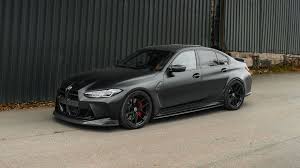Modding a car like the G80 M3 is a rite of passage. The parts show up in the mail, the excitement kicks in, and before you know it, your garage turns into a mini pit stop. But there’s one thing too many people overlook when bolting on upgrades: protecting the factory finish.
A single slip during installation can leave you with a scratch you’ll stare at every time you wash the car. Or worse, torn trim and chipped paint around that brand-new lip spoiler you were proud of. The M3 deserves better, and so does your investment.
Whether you’re upgrading the exhaust, swapping wheels, or adding aero parts, the way you prep can make or break the look of your car.
Start With a Clean Slate
Before touching a bolt, clean the car. You’re working close to the body, so dust, grit, and road grime can end up being dragged across panels by your tools, sleeves, or hands.
Use a pH-balanced soap and two-bucket method. Follow up with a quick detailer or panel wipe around the areas where you’ll be installing parts. That includes bumpers, skirts, fenders, and underbody edges. Any leftover dirt can scratch the clear coat when pressure is applied.
Microfiber towels are your best friend here. Use them generously and replace them if they feel rough.
Tape the Danger Zones
Painter’s tape should be in every modder’s toolbox. It’s not just for masking when painting. You can apply it to the edges of bumpers, the bottom of the hood, or the fender area near your tools to act as a buffer.
Don’t rely on your memory or caution during installation. Accidents happen when you’re focused on aligning a bracket or tightening something underneath. The tape helps take the stress off those moments.
Some shops even use foam edge guards. If you’re doing a splitter install, placing these on the lower front lip will help you avoid those dreaded “first scrape” feelings.
Be Smart With Your Tools
Even plastic pry tools can scuff glossy paint if you twist too hard. Stick to high-quality trim tools and learn which ones work best for each clip. Avoid flathead screwdrivers on interior trim or soft-touch plastics. They leave marks that can’t be undone without refinishing.
Magnetic screwdrivers can save you from dropped bolts, especially near the engine bay. It sounds minor, but dropping a bolt onto a painted surface and chasing it with your hand is how scratches happen.
Don’t Rush Paint-to-Paint Contact
Not all parts fit out of the box. That carbon lip or diffuser might need a bit of coaxing, especially if it’s aftermarket. If you’re forcing it to line up, you’re putting pressure on nearby surfaces.
Use soft foam or padding under test-fitted parts before the final installation. This keeps the underside from grinding against the bumper while you figure out alignment.
Dry fitting first also helps you avoid the bigger mistake of pulling off the adhesive backing and realizing you’re off-center.
Be Extra Cautious Around Double-Sided Tape and Sealants
Most trim parts and splitters use 3M automotive tape or some kind of bonding agent. When applied right, they stay on for years. When applied incorrectly, they peel, pull, and sometimes rip clear coats with them.
Don’t skip the adhesion promoter. It helps the tape grip, especially on curved surfaces. Just be careful not to let it run past the edge of the part, as some formulas can stain paint or plastic if wiped too late.
When removing badges or parts that were installed with adhesive, always heat the area gently and use a fishing line, not metal or hard plastic scrapers. This avoids dragging the adhesive across the surface, which can scratch or dull paint.
Coating and Wraps Give You Breathing Room
Once the mods are installed, consider ceramic coating the contact areas. A coating makes it easier to clean, helps repel contaminants, and gives you an extra barrier between your new parts and road debris.
For those going more aggressive with aero kits, a clear bra or full PPF wrap is worth the money. It protects against rock chips and scratches during day-to-day driving and offers peace of mind if you ever remove or swap parts again.






